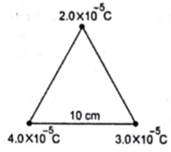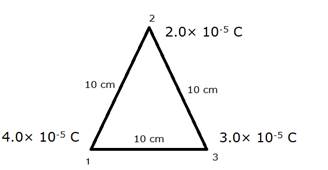How much work has to be done in assembling three charged particles at the vertices of an equilateral triangle as shown in figure?
Given:
Charge at 1 : q1 = 4.0 × 10-5 C
Charge at 2 : q2 = 2.0 × 10-5 C
Charge at 3 : q3 = 3.0 × 10-5 C
Let side of the equilateral triangle be L = 10 cm = 0.1 m
Formula used:
To assemble the charges at three vertices electric potential energy is required.
Thus, the work done in assembling these charges is equal to the total electric potential energy used.
W = U12 +U23 + U31
Here, W is the work done.
U12: Electric Potential energy due to charges at 1 and 2 having separation 0.1 m.
U23 : Electric Potential energy due to charges at 2 and 3 having separation 0.1 m.
U31: Electric Potential energy due to charges at 3 and 1 having separation 0.1 m.
Formula for Electric potential energy is:![]() Here, k is a constant and k=
Here, k is a constant and k= ![]() =9× 109 Nm2C-2 , q1 and q2 are point charges and r is the separation between them and U is the electric potential energy required to moves charges q1 and q2 apart.
=9× 109 Nm2C-2 , q1 and q2 are point charges and r is the separation between them and U is the electric potential energy required to moves charges q1 and q2 apart.
Substituting,![]()
![]()
![]()
![]() Hence, 234 J of work is required for assembling the charges at the vertices of the equilateral triangle.
Hence, 234 J of work is required for assembling the charges at the vertices of the equilateral triangle.